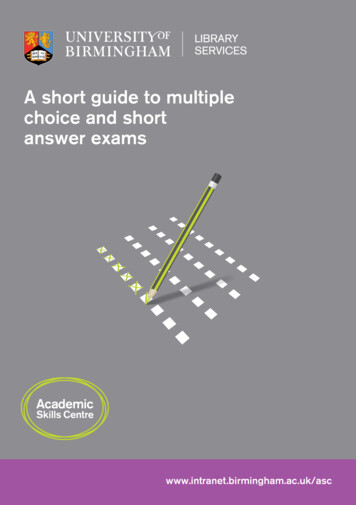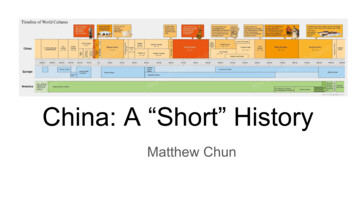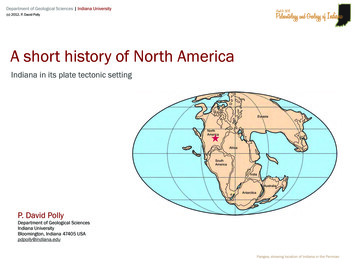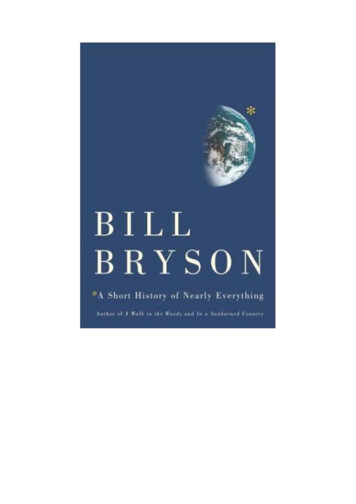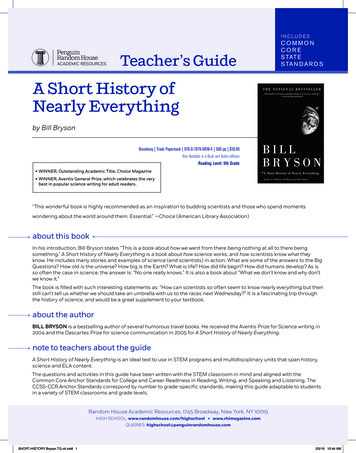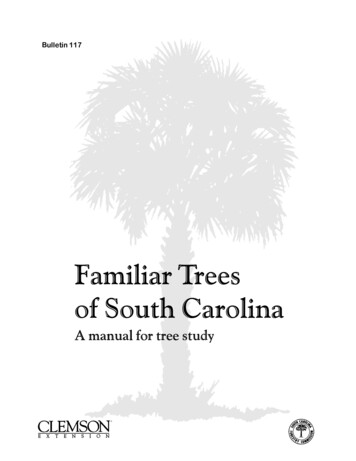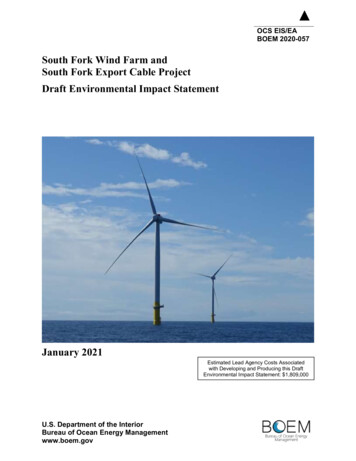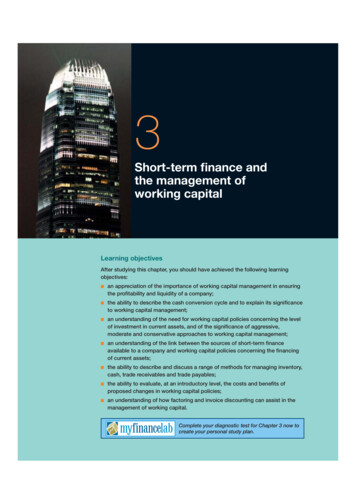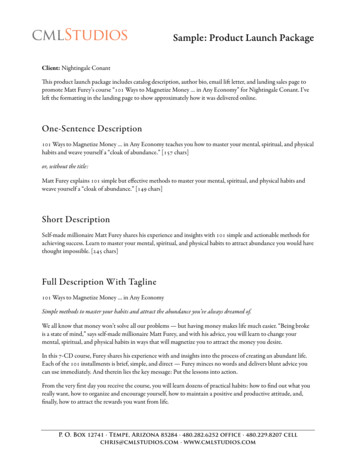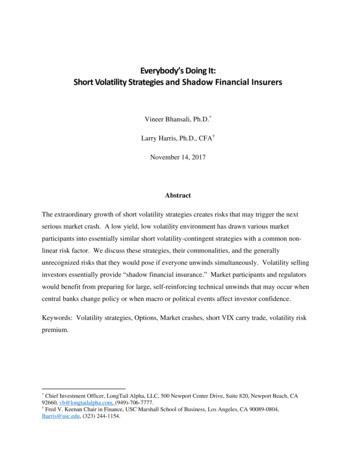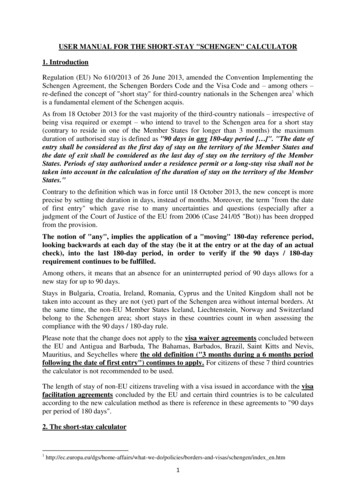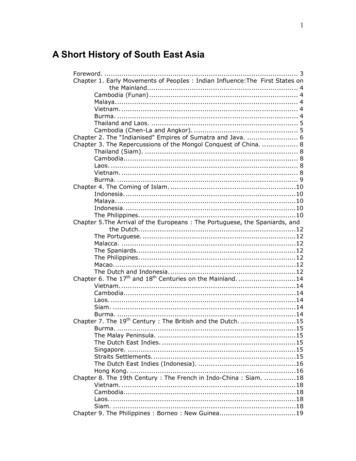
Transcription
1A Short History of South East AsiaForeword. . 3Chapter 1. Early Movements of PeopIes : Indian Influence:The First States onthe Mainland. 4Cambodia (Funan). 4Malaya. 4Vietnam. . 4Burma. . 4Thailand and Laos. . 5Cambodia (Chen-La and Angkor). . 5Chapter 2. The "Indianised" Empires of Sumatra and Java. . 6Chapter 3. The Repercussions of the Mongol Conquest of China. . 8Thailand (Siam). . 8Cambodia. 8Laos. . 8Vietnam. . 8Burma. . 9Chapter 4. The Coming of Islam. .10Indonesia. .10Malaya.10Indonesia. .10The Philippines.10Chapter 5.The Arrival of the Europeans : The Portuguese, the Spaniards, andthe Dutch.12The Portuguese. .12Malacca. .12The Spaniards.12The Philippines.12Macao.12The Dutch and Indonesia.12Chapter 6. The 17th and 18th Centuries on the Mainland. .14Vietnam. .14Cambodia.14Laos. .14Siam. .14Burma. .14Chapter 7. The 19th Century : The British and the Dutch. .15Burma. .15The Malay Peninsula. .15The Dutch East Indies. .15Singapore. .15Straits Settlements.15The Dutch East Indies (Indonesia). .16Hong Kong. .16Chapter 8. The 19th Century : The French in Indo-China : Siam. .18Vietnam. .18Cambodia.18Laos. .18Siam. .18Chapter 9. The Philippines : Borneo : New Guinea.19
2The Philippines.19Borneo.19Timor and New Guinea. .19Chapter 10. The Early Years of the 20th Century : Movements for Independence.21French Indo-China. .21Dutch East Indies. .22Burma. .22Malaya.22The Philippines.22Siam. .22Chapter 11. The Second World War : The Conquest and Loss of South EastAsia .23Chapter 12. Independence and After : The Philippines. .25Chapter 13. Independence and After : Burma.27Chapter 14. Independence and After : Malaysia and Singapore .28Malaysia .28Singapore. .29Chapter 15. Independence and After : Indonesia. .30Chapter 16. Independence and After : Vietnam, Cambodia, Laos. .32Vietnam. .32Cambodia.33Laos. .33Chapter 17.Remnants of the Colonial Empires. .35Hong Kong. .35Macao and Eastern Timor. .35Papua / New Guinea. .35Brunei. .35Chapter 18.Thailand Since the Second World War. .36Indonesia. .38Thailand.38The Philippines.39Burma. .39Malaysia. .39Singapore. .40Hong Kong .40Papua New Guinea. .40Brunei. .41Macao.41Eastern Timor. .41Vietnam. .41Khmer Republic (Cambodia).41Laos. .42Map:South East Asia to the 14th Century .43Map:The Mainland (15th to 18th Centuries) .44Map:South East Asia in 1900.45Map:South East Asia in 1970 .46
3Foreword.South East Asia is taken in this history to include the countries of the Asian mainlandsouth of China, from Burma in the west to Vietnam in the east and the islands fromSumatra in the west to the Philippines and New Guinea in the east.It does not include Taiwan (Formosa), whose history seems to be more naturally partof that of China. But it does include Hong Kong and Macao, the British andPortuguese possessions on the south China coast, as their history is bound up withthat of South East Asia rather than with that of China.With so many different countries being covered, the history of any one country isnecessarily fragmented. The following index makes it possible to read the history ofeach, if so desired, more or less consecutively.
4Chapter 1. Early Movements of PeopIes : Indian Influence : TheFirst States on the Mainland.The peoples of maritime South East Asia - present-day Malaysia, Indonesia and thePhilippines - are thought to have migrated southwards from southern Chinasometime between 2500 and 1500 B.C. They continued to have contacts with theChinese civilisation (well established in the second millenium B.C.), but the influenceof the other long-established civilisation of India gradually became predominantamong them, and among the peoples of the South East Asia mainland.Indian traders*, adventurers, teachers and priests continued to be the dominatinginfluence in South East Asia until about A.D. 1500, and Indians often ruled theearliest states in these regions. Hinduism and Buddhism both spread to these statesfrom India and for many centuries existed there with mutual toleration. Eventuallythe states of the mainland became mainly Buddhist.Cambodia (Funan). The first of these “Indianised” states to achieve widespreadimportance was Funan, in Cambodia, founded in the 1st century A.D. - according tolegend, after the marriage of an Indian Brahman into the family of the local chief.These local inhabitants were the Khmer people. Khmer was the former name ofCambodia, and Khmer is their language.The Hindu-Khmer empire of Funan flourished for some 500 years. It carried on aprosperous trade with India and China, and its engineers developed an extensivecanal system. An elite practised statecraft, art and science, based on Indian culture.Vassal kingdoms spread to southern Vietnam in the east and to the Malay peninsulain the west.Malaya. The Malay peninsula had been settled during the period around 2000 to1500 B.C. by Mongoloid tribes from south-western China, who mixed with othertribes to become the ancestors of the Malays. The Malays came under Indianinfluence from about the beginning of the Christian era.Vietnam. At the eastern extremity of South East Asia, northern Vietnam wasoriginally occupied by Indonesian peoples. About 207 B.C. a Chinese general, takingadvantage of the temporary fragmentation of the Chinese Expire on the collapse ofthe Ch’in dynasty, created in northern Vietnam the kingdom of Annam. During thefirst century B.C. Annam was reincorporated in the Chinese Empire of the Handynasty; and it remained a province of the Expire until the fall of the T'ang dynastyearly in the 10th century. It then regained its independence, often as a nominalVassal of the Chinese Emperor.In south-central Vietnam the Chams, a people of Indonesian stock, established theIndianised kingdom of Champa about A.D.400. Although subject to periodic invasionsby the Annamese and by the Khmers of Cambodia, Champa survived and prospered.Burma. At the western end of the South East Asian mainland, Lower Burma wasoccupied by the Mon peoples, who are thought to have come originally from westernChina. In Lower Burma they supplanted an earlier people, the Pyu, of whom little isknown except that they practised Hinduism. The Mons, strongly influenced by their
5contacts with Indian traders as early as the 3rd century B.C, adopted Indian literatureand art and the Buddhist religion; and theirs was the earliest known civilisation inSouth East Asia. There were several Man kingdoms, spreading from Lower Burmainto much of Thailand, where they founded the kingdom of Dvaravati. Their principalsettlements in Burma were Thaton and Pegu.From about the 9th century onwards Tibeto-Burman tribes moved south from thehills east of Tibet into the Irrawaddy plain, founding their capital at Pagan in UpperBurma in the 10th century. They eventually absorbed the Mons and their cities, andadopted the Mon civilisation and Buddhism. The Pagan kingdom united all Burmaunder one rule for 200 years from the 11th to 13th centuries. The zenith of its powerwas in the reign of King Anawratha (1044-1077), who conquered the Mon kingdomof Thaton. He also built many of the temples for which Pagan is famous. It isestimated that some 13,000 temples once existed in the city - of which some 5,000still stand.Thailand and Laos. At about the same time as the Burmese invasion of Burma,another group of people, the Thai, began moving south and west from theirhomeland, the Thai kingdom of Nan Chao in southern China. They settled in northernThailand, and later, in the 10th and 11th centuries, in Loas.Cambodia (Chen-La and Angkor). To return to Cambodia:- Late in the 6th centuryA.D. dynastic struggles caused the collapse of the Funan empire. It was succeededby another Hindu-Khmer state, Chen-la, which lasted until the 9th century.Then, a Khmer king, Jayavarman II (about 800-850) established a capital at Angkorin central Cambodia. He founded a cult which identified the king with the Hindu GodSiva - one of the triad of Hindu gods, Brahma the creator, Vishnu the preserver, Sivathe god symbolising destruction and reproduction.The Angkor expire flourishes from the 9th to the early 13th century. It reached thepeak of its fame under Jayavarman VII at the end of the 12th century, when itsconquests extended into Thailand in the west (where it had conquered the Monkingdom of Dyaravati) and into Champa in the east. Its most celebrated memorial isthe great temple of Angkor Wat, built early in the 12th century.This summarises the position cm the South East Asian mainland until about the 12thcentury. Meanwhile, from about the 6th century, and until the 14th century, there wasa series of great Maritime empires based on the Indonesian islands of Sumatra andJava.* In early days these Indians same mostly from the ancient Dravidian Kingdom ofKalinga, on the south-eastern coast of India. Indians in Indonesia are still known as"Klings", derived from Kalinga.
6Chapter 2. The "Indianised" Empires of Sumatra and Java.In the islands of South East Asia the first organised state to achieve fame was theHindu-ised Malay kingdom of Srivijaya, with its capital at Palembang in southernSumatra. Its commercial pre-eminence was based on command of the sea routefrom India to China between Sumatra and the Malay peninsula (later known as theStraits of Malacca).In the 6th – 7th centuries Srivijaya succeeded Funan as the leading state in SouthEast Asia. Its ruler was the overlord of the Malay peninsula and western Java as wellas Sumatra. Like most of the early kingdoms of South East Asia, Srivijaya was Indianin culture and administration, and Buddhism became firmly entrenched there.The expansion of Srivijaya was resisted in eastern Java, where the powerful BuddhistSailendra dynasty arose. (From the 7th century onwards there was great activity intemple building in eastern Java. The most impressive of the ruins is at Borobudur,considered to have been the largest Buddhist temple in the world.)Sailendra rule spread to southern Sumatra, and up to Malay peninsula to Cambodia(where it was replaced by the Angkor kingdom). In the 9th century the Sailendrasmoved to Sumatra, and a union of Srivijaya and the Sailendras formed an empirewhich dominated much of South East Asia for the next five centuries. With the departure of the Sailendras a new kingdom appeared in eastern Java, whichreverted from Buddhism to Hinduism. In the 10th century this kingdom, Mataran,challenged the supremacy of Srivijaya, resulting in the destruction of the Matarancapital by Srivijaya early in the 11th century. Restored by King Airlangger (about1020-1050), the kingdom split on his death; and the new state of Kediri, in easternJava, became the centre of Javanese culture for the next two centuries, spreading itsinfluence to the eastern part of island South East Asia.The spice trade was now becoming of increasing importance, as the demand byEuropean countries for spices grew. (Before they learned to keep sheep and cattlealive in the winter, they had to eat salted meat, made palatable by the addition ofspices.) One of the main sources was the Molucca Islands (or "Spice Islands") inIndonesia, and Kediri became a strong trading nation.In the 13th century, however, the Kediri dynasty was overthrown by a revolution, andanother kingdom arose in east Java. The domains of this new state expanded underthe rule of its warrior-king Kartonagoro. He was killed by a prince of the previousKediri dynasty, who then established the last great Hindu-Javanese kingdom,Majapahit.By the middle of the 14th century Majapahit controlled most of Java, Sumatra andthe Malay peninsula, part of Borneo, the southern Celebes and the Moluccas. It alsoexerted considerable influence on the mainland. After 500 Years of supremacySrivijaya was superseded by Majapahit.The various Indianised states and empires of this first 1500 years A.D., thoughfounded by Indian colonisation and maintaining diplomatic contacts with India,remained politically independent of the Indian kingdoms. The only exception to this
7was the temporary conquest of Malaya by the Chola kingdom of southern India it the11th century, but the Sailendra kings of Srivijaya were victorious in a long waragainst the Chola armies.
8Chapter 3. The Repercussions of the Mongol Conquest ofChina.At the beginning of the 13th century the situation on the mainland was in Burma thePagan kingdom; the Malay peninsula under Srivijaya-Sailendra rule; in Cambodia theKhmer kingdom of Angkor, also ruling some of Thailand; Thai settlements innorthern Thailand and Laos; and in Vietnam the kingdom of Annam in the north andChampa in the south.Then the great Mongol irruption in the 13th century hail repercussions throughoutSouth East Asia. Early in the century the first of the Mongol leaders, Jenghis Khan,conquered northern China; and in 1251 his grandson Kublai Khan, appointedGovernor of China, set about the subjugation of the south.Thailand (Siam). In the course of this subjugation the ancient Thai kingdom of NanChao in Yunnan (southern China) was crushed. The result was a mass movement ofThai peoples southwards. At first divided into principalities, vassals of the Khmerking, they founded in 1238 the kingdom of Sukothai in west central Thailand. KingRamkamhaeng adopted the Khmer alphabet and gave the Thais a written language;and he introduced Buddhism into his kingdom.In 1350 Prince Ramatibodi founded a rival Thai kingdom in the south, with its capitalat Ayuthhia. This soon superseded Sukothai. Ramatibodi, generally regarded as thefirst King of Siam (or Thailand) was an enlightened ruler. He brought in a new coreof law and his armies drove the Khmer back into Cambodia. The Ayuthhia kingdomsurvived for over 400 years, for much of which Siam was engaged in war with theKhmer in the east and then with Burma in the west.Cambodia. In the 13th century the Khmer kingdom in Cambodia began to decline,owing to a succession of weak rulers, and perhaps due to the undermining of theBrahman government by the spread of Buddhism. Thai invasions in the late 13th andearly 14th centuries three times captured Angkor, which was abandoned in 1431 asbeing within too easy reach of Thai expeditions.The capital was moved to Phnom Penh in south eastern Cambodia. Thereafter theKhmer domains steadily diminished. The Thais encroached in the north and west,and the Vietnamese in the east. The Khmer kings were forced from time to time torecognise Siamese suzerainty.Laos. In 1353 - about the same time as the foundation of the Thai kingdom ofAyuthhia - a Buddhist Thai settlement at Luang Prabang in northern Laos unitedneighbouring communities to form the first Laotian kingdom of Lan Xang (the "landof a million elephants'). Two hundred years later, conflict with Siam and Burmaforced the transfer of the capital further south, to Vientiane, but the kingdommaintained its independence.Vietnam. Further east, Champa in southern Vietnam was subjected in the 13thcentury to further attacks by the northern Vietnam kingdom of Annam (and towardsthe end of the century Kublai Khan sent unsuccessful expeditions against both
9Annam and Champa). In the 14th century Champa became a vassal of Annam, and inthe next century was gradually absorbed by Annam until it finally disappeared.During the 16th century Annam was divided by civil war, but at the end of thecentury it was re-united under the Trinh dynasty.Burma. In Burma, Kublai Khan’s conquest of southern China had devastatingrepercussions. The Pagan kingdom rejected Kublai Khan's demands for tribute - andraided Yunnan - whereupon the Mongol armies invaded Burma (1287) and the powerof Pagan was destroyed.The disruption was taken advantage of by some of the Thai tribes (known in Burmaas Shans) displaced from Nan Chao. They moved into Burma and set up a number ofpetty states in the centre and north of the country. In the south the Monsestablished a state based on Pegu (notable for having for a time in the 15th centurythe only female ruler in Burmese history - Queen Shin Sawba).The Burmese abandoned Pagan, which was occupied by the Mongols for thirty years,and in 1365 made Ava in central Burma their new capital. Further south, Toungoobecame another centre of Burmese power.Two centuries later, in 1527, Ava was captured and destroyed by the Shans, andToungoo became the Burmese capital. King Tabin Shweti (1531-1550) of theToungoo dynasty then conquered the Mon kingdom of Pegu and such of centralBurma. His successor Bayinnaung subjugated the Shans, took Ava, and for a timeSiam and Luang Prabang (Laos) came under his control.The Thais soon recovered, and invaded Burma. This, and internal rebellions, brokeup Burma into a collection of small states, which were re-united in the 17th centuryby King Anaukpetlun. He moved the capital back to Ava, and Burma under theToungoo dynasty then retired into isolation from the outside world for the nexthundred years.
10Chapter 4. The Coming of Islam.Indonesia. To return to maritime South East Asia: we have seen (end of Chapter2) that in the middle of the 14th century the Hindu-Javanese kingdom of Majapahitheld sway over an island empire and exerted considerable influence on the mainland.But it was already facing two threats to its commercial and cultural eminence. InMalaya it was challenged by the rising power of Siam; and in the islands its authoritywas being undermined by the arrival of Islam.The islands had been in contact with Islam, through Arab traders, for manycenturies; but their traditional cultural dependence on India prevented Islam frombeing acceptable to them until Islam was firmly established under Moslem rulers inthe north of India itself, at about the end of the 12th century. Then, in the 13thcentury, Indian merchants from Gujerat (in north-western India) converted to Islamsome of the ports of northern Sumatra. From there Islam spread to the Malaypeninsula, Java, and the Philippines.Malaya. In Malaya the rise of Islam was bound up with the foundation andsubsequent importance of the settlement of Malacca on the west coast. It wasfounded at the beginning of the 15th century, traditionally by a Sumatran prince,Parameswara, who had fled from the island of Temasek (Singapore). (Temasek inthe late 14th century was the scene of struggles between the failing power ofSrivijaya, its successor Majapahit, and Siam. In the course of these struggles it wasdestroyed.)Parameswara was converted to Islam, which under him and subsequent rulersspread throughout the peninsula. Malacca, situated at a strategic point on the traderoutes linking India, South East Asia and China, became the main trading port of theEast.For a hundred years (the 15th century) Malacca maintained its independence,protected in its early years from Siamese aggression by the diplomatic activity of theMing rulers of China.* And Malacca became the centre of Islam in South East Asia.Indonesia. Meanwhile in Indonesia the Majapahit empire broke up into a number ofsmall and weak Moslem states. The island of Bali alone remained - and still remains Hindu in religion.The Philippines. The Philippines, so far barely mentioned in this history, had beenoccupied for many centuries by a mixture of Malays and Indonesians who wereorganised in tribal units known as “barangays". They had their own culture, andtraded extensively with Indian, Chinese, and Arab merchants; but they seen to havemanaged to keep themselves isolated from the various imperial struggles of SouthEast Asia. Many of them were converted to Islam during the 13th to 15th centuries,but they remained uninvolved in outside affairs until the Europeans arrived there inthe 16th century.Apart from Malaya, Islam made little impact on the mainland of South East Asia,which remained overwhelmingly Buddhist.
11*Between 1405 and 1433 China sent many naval expeditions and diplomaticmissions to all the lands bordering the Indian Ocean and the South China Seas. Theywent in search of commerce and military prestige. Then this activity suddenly ceased- leaving the way open for the subsequent exploitation of the Far East by Europeans.The reasons for the change of policy were purely domestic - mainly the jealousy ofthe civil service of an enterprise which was commanded by a palace eunuch, theMoslem Chang Ho, and not under their control.
12Chapter 5. The Arrival of the Europeans : The Portuguese, theSpaniards, and the Dutch.The Portuguese. Towards the end of the 15th century the Portuguese launched aseries of great voyages of exploration, aimed at establishing trade routes to the East- particularly to India and to the Spice Islands. (These islands had been described byMarco Polo after his return from China nearly two centuries earlier.)In 1488 Bartholomew Diaz rounded the south of Africa. Ten years later Vasco deGoma reached India by this route. In 1505 the Portuguese conquered most ofCeylon, and in 1510 they founded the trading settlement of Goa on the west coastof India.Malacca. Now masters of the sea routes in the Indian Ocean, the Portugueserealised the vital importance of Malacca to the economic domination of South EastAsia. In 1511 they attacked and captured it from the Moslem rulers. They thenaimed at control of the Spice Islands (the Moluccas), and here they encountered therivalry of Spain.The Spaniards. In 1519 Ferdinand Magellan, a Portuguese in the service of Spain,set out for the Moluccas via the south of America. He reached the Philippines, wherehe was killed in an encounter with the inhabitants; but some of his fleet continued tothe Moluccas - and eventually one ship got back to Spain, the first to circumnavigatethe globe.The rivalry of Spain and Portugal in the Moluccas ended with the Portuguese incontrol, whereupon Spain turned her attention to the Philippines.The Philippines. In the course of twenty years from 1564 the Spaniards conqueredmost of the Philippine islands from the local Moslems. The islands were named thePhilippines in honour of King Philip II of Spain. The capital was the Spanish fortresssettlement of Manila. The Spanish priests set about the conversion of the inhabitantsto Roman Catholicism; and as previous cultures had had much less impact in theseislands than in the rest of South East Asia the Filipinos, in the course of the followingcenturies, became almost completely Christianised and Westernised. Spanish rulecontinued for over three centuries, until 1898.Macao. Portuguese domination of the Asian sea trade routes was further extendedby the acquisition from China in 1557 of the lease of Macao on the Chinese mainland(near Hong Kong) - as a reward for overcoming the pirates of the south China seas.Macao later became a Portuguese possession, which it still is.But towards the end of the 16th century Portuguese pre-eminence in the East beganto wane, particularly after 1580 when their royal line died out and Portugal wasunited - forcibly - with Spain under Philip II. (Portugal regained her independence 60years later, in 1640.)The Dutch and Indonesia. Spain was at this time engaged in a long struggle inEurope to retain possession of the Netherlands. In Belgium she succeeded, but theDutch won their independence, nominally in 1648, but in practice some 40 yearsearlier. The deciding factor in this struggle was the Dutch prowess at sea, and long
13before the end of the war adventurous Dutchmen were sailing far and wide in searchof trade.When Portugal came under his rule, Philip of Spain closed the port of Lisbon to theDutch. This led to a great expansion of Dutch shipping, which now went to the EastIndies for the spices previously picked up at Lisbon. The Dutch East India Companywas formed in 1601, and soon displaced the Portuguese as the dominant tradingpower in the East. (The English also formed their East India C
South East Asia is taken in this history to include the countries of the Asian mainland south of China, from Burma in the west to Vietnam in the east and the islands from Sumatra in the west to the Philippines and New Guinea in the east. It does not include Taiwan (Formosa), whose history
